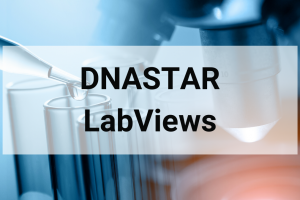MADISON, Wisconsin – September 30, 2016 – DNASTAR® announced the release of Lasergene 14 today, which includes a broad range of improvements in DNA, RNA and protein sequence and structure prediction and analysis. Lasergene 14 includes three brand new applications: GenVision Pro, a comprehensive genome browser; NovaDock, a protein-protein docking application; and NovaFold Antibody, a specific antibody structure prediction program. Also included in this release are major enhancements to virtual cloning, including the addition of three new cloning methods, newly integrated combined Next Generation Sequencing (NGS) workflows, enhancements to the de novo transcriptome workflow introduced with Lasergene 13, and a workflow in support of Sanger validation of NGS data.
GenVision Pro is a comprehensive browser for single or multiple genomes that enables all scientists to visualize, browse, and compare multiple genome-scale assemblies in an easy to use interface. It supports analysis of combined workflows (e.g. RNA-Seq and ChIP-Seq or CNV and miRNA) to facilitate integrated analysis of important experiments.
NovaDock is a protein-protein docking algorithm that predicts atomic interactions between any two proteins, with results able to be visualized in Lasergene’s Protean 3D application. NovaDock utilizes the SwarmDock algorithm, which exploits protein flexibility when docking, resulting in more accurate predictions.
NovaFold Antibody is a new application designed to predict antibody structures, identify antibody-antigen binding sites, and, with the use of NovaDock, simulate and display the effects of binding. NovaFold Antibody was developed in-house at DNASTAR using a broad range of tools to assist antibody researchers.
Lasergene 14 includes a streamlined cloning workflow and the addition of three new cloning methods into DNASTAR software: Gibson Assembly, In-Fusion and GeneArt. Lasergene now supports seven major virtual cloning approaches and variations of them, allowing scientists to choose from a broad range of popular cloning methods to accomplish their research objectives.
The de novo transcriptome workflow has been enhanced to allow for rRNA contaminant screening and elimination of ribosomal RNA from experimental data. Adaptor trimming is also supported. When combined with annotation via the most appropriate RefSeq database, which was introduced in Lasergene 13, the enhanced de novo transcriptome workflow is truly industry leading.
Lasergene users who perform sequencing for clinical research or who perform high throughput sequencing of specific samples often have the need to validate next-generation sequencing results with Sanger assemblies. In Lasergene 14, scientists can now view NGS and Sanger data within a single project to validate sample results before further proceeding.
Tom Schwei, Vice President and General Manager of DNASTAR, commented, “Lasergene 14 is a transformative software release. Biology is becoming increasingly integrated and extended. Scientists are no longer interested in simply performing one type of experiment on their organism of interest. They perform multiple experiments and they need software to help them combine the results into an integrated analysis platform. Lasergene 14 can support scientists by going from DNA sequence to protein structure and beyond, with a broad range of tools for all life scientists. We are delighted to be able to deliver this robust offering to the market. We continue to focus on incorporating the highest quality algorithms into our software, whether developed in-house or brought in from leaders in the field. We look forward to continuing to deliver the most accurate and comprehensive results in our biological software.”
About DNASTAR
DNASTAR, Inc., Madison, Wisconsin, (www.DNASTAR.com) is a pioneer in the development and sale of software used to increase life scientists’ productivity using their desktop computer or on the Amazon Cloud. DNASTAR’s comprehensive software suite, Lasergene, supports molecular biologists, geneticists, and structural biologists in meeting virtually all of their DNA, RNA, and protein sequence needs, including Sanger and next-generation sequence assembly and analysis, protein sequence and structure analysis, protein structure prediction, and protein-protein docking with easy to use, affordable, flexible computer software.
Contact
Tom Schwei
Vice President & General Manager
DNASTAR, Inc.
Telephone: 608-237-3082
U.S. Toll Free: 866-511-5090
toms@dnastar.com





Leave a Reply
Your email is safe with us.